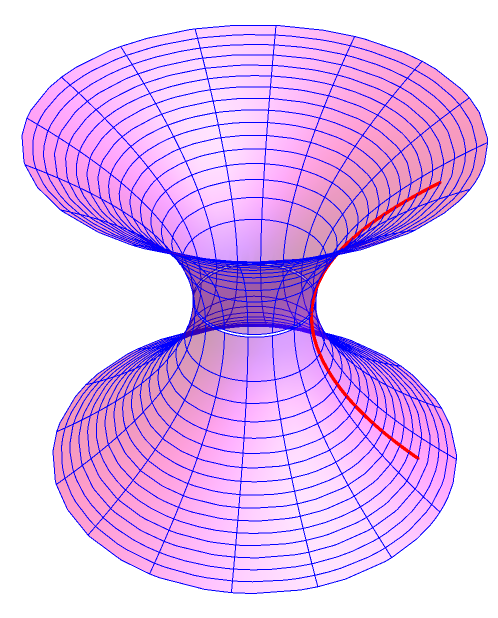I'm having tremendous trouble plotting geodesic trajectories on wormhole embedding. I'm attaching the article from which I am trying to re-create the trajectories (https://arxiv.org/pdf/1404.7210.pdf). I've already achieved the wormhole embedding shape, but couldn't plot the geodesic trajectories. The author described the technique (pdf page 7), described that they numerically inverted the solution to obtain $r(\phi)$, so they could use it in ParametricPlot3D as $ r(\phi) cos(\phi),r(\phi) sin(\phi),z(r(\phi)) $. Please do help to plot the trajectories. Please make some coding recommendations.
Here is a code I used that doesn't plot.
In[1]:= DSolve[r'[h] == (1 - 2/r[h])^(-(1/2)), r[h], h]
In[2]:= s1 = NDSolve[{h'[x] == \[Sqrt](0.95^2/
4 (InverseFunction[(-((2 Log[Sqrt[-2 + #1] + Sqrt[#1]])/
Sqrt[-2 + #1]) + Sqrt[#1]) Sqrt[(-2 + #1)/#1]
Sqrt[#1] &][
h[x]])^4 - (InverseFunction[(-((
2 Log[Sqrt[-2 + #1] + Sqrt[#1]])/Sqrt[-2 + #1]) +
Sqrt[#1]) Sqrt[(-2 + #1)/#1] Sqrt[#1] &][h[x]])^2),
h[0] == 5}, h, {x, 0, 10}]
In[3]:= ParametricPlot3D[
Evaluate[{Cos[x] h[x], Sin[x] h[x], 4 Sqrt[-1 + h[x] /2]} /.
s1], {x, 0, 25}, PlotRange -> All]
Thank you.




ParametricPlot3D[ Evaluate[{Cos[x] h[x], Sin[x] h[x], 4 Sqrt[-1 + h[x]/2]} /. s1[[1]]], {x, 0, 25}, PlotRange -> All]$\endgroup$qin your code? $\endgroup$